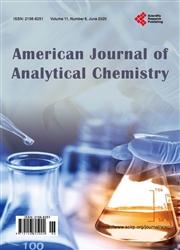Controlling the Shape, Pore Size and Surface Area of Prepared Mesoporous Silica Particles by Altering the Molar Concentration of Tetramethoxysilane
引用次数: 1
Abstract
In recent days, the applications of silica-based nanoparticles have gained much attention. The preparation of mesoporous silicas is usually achieved via the modified Stöber method, the reaction attained by the hydrolysis and con-densation of silica precursors present within a medium containing template, solvent, deionized water (DI-W) and base. Therefore, the current study aimed to prepare and characterize mesoporous silicas by using tetramethoxysilane (TMOS) as silica precursor and ethylene glycol (Et-G) as solvent. The study was based on the template dodecyltrimethylammonium bromide (C 12 TMABr) and sodium hydroxide used as an alkaline agent. Mesoporous silicas were prepared in various batches based on TMOS molar concentration, ionized water, NaOH, and other solvents. The characterization of mesoporous silicas was achieved based on their specific surface area, pore size distribution and morphology using different instruments: Brunauer, Emmett & Teller (BET), scanning electron microscopy (SEM), Fourier-transform infrared spectroscopy (FT-IR), and thermalgravimetric analysis (TGA). The study revealed that shape, average particle sizes “35 to 550 nm”, average pore radius “1.62 - 4.5 nm” and surface area “350 - 1204 m 2 ∙g −1 ” of obtained mesoporous silica particles were altered based on precursor concentration and other factors. Therefore, it is important to get the most suitable concentration通过改变四甲基氧基硅烷的摩尔浓度来控制介孔二氧化硅颗粒的形状、孔径和表面积
近年来,硅基纳米颗粒的应用受到了广泛的关注。介孔二氧化硅的制备通常是通过改进Stöber方法来实现的,该反应是通过在含有模板、溶剂、去离子水(DI-W)和碱的介质中水解和缩合二氧化硅前驱体来实现的。因此,本研究旨在以四甲基氧基硅烷(TMOS)为前驱体,乙二醇(Et-G)为溶剂制备介孔二氧化硅并对其进行表征。本研究以十二烷基三甲基溴化铵(c12tabr)为模板剂,氢氧化钠为碱性试剂。根据TMOS摩尔浓度、电离水、氢氧化钠和其他溶剂的不同,制备了不同批次的介孔二氧化硅。采用Brunauer, Emmett & Teller (BET),扫描电子显微镜(SEM),傅里叶变换红外光谱(FT-IR)和热重分析(TGA)等不同的仪器对介孔二氧化硅的比表面积,孔径分布和形貌进行了表征。研究表明,前驱体浓度等因素改变了介孔二氧化硅颗粒的形状,平均粒径为35 ~ 550 nm,平均孔半径为1.62 ~ 4.5 nm,比表面积为350 ~ 1204 m2∙g−1。因此,获得最合适的浓度是很重要的
本文章由计算机程序翻译,如有差异,请以英文原文为准。
求助全文
约1分钟内获得全文
求助全文

 求助内容:
求助内容: 应助结果提醒方式:
应助结果提醒方式:


